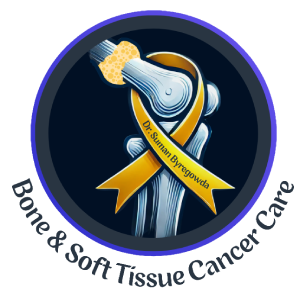

Bone cancer refers to a type of cancer that originates in the bone cells. It can be classified as
primary (starting in the bone) or secondary (metastasized from other areas, such as the lungs
or breast). Primary bone cancers include osteosarcoma, chondrosarcoma, and Ewing’s
sarcoma, among others.
The exact cause of bone cancer is not always clear, most of them not hereditary so no risk to immediate family
A biopsy is often the definitive test to confirm the diagnosis of bone cancer. During a biopsy, a small sample of tissue from the tumor is removed and examined under a microscope. There are two main types of biopsies:
The treatment for bone cancer depends on the type of bone cancer, its stage (how far it has spread), its location, and the patient’s overall health. The main treatment options for bone cancer include surgery, chemotherapy and radiation therapy,
Yes, limb-salvage surgery is a type of surgery used to treat bone cancer that allows the limb
to be preserved while removing the tumor, it helps maintain function and quality of life after
treatment. With Modern surgical techniques we can save limb (hand/leg) in more than
90-95 percent of patients
Prosthetic Implants: In some cases, a metal or plastic prosthetic device is used to replace the removed portion of the bone, especially if the tumor is in the knee or hip area.
No, bone cancer is not typically hereditary and does not directly spread to family members. Bone cancer is caused by mutations in the cells of the bone, and while these mutations are not contagious.
Yes, bone cancer can come back after treatment, and this is known as a recurrence. Usually, recurrence is seen in first 2-3 years after treatment, after that risk significantly comes down. After 5 years chance of recurrence becomes negligible. High risk patients are large size cancer, if cancer has spread to other part of the body, Recurrent Cancer, Poor responder for Chemotherapy, if surgical removal is not possible.
Orthopedic oncologists specialize in cancers of the bones and soft tissues, including bone cancer (like osteosarcoma, Ewing’s sarcoma, etc.). They have the specialized knowledge to understand the unique nature of these cancers and how they affect bones, joints, and surrounding structures.
Bone cancer requires accurate diagnosis and staging to determine the exact type of cancer and whether it has spread. Orthopedic oncologists have experience using advanced imaging techniques (X-rays, MRI, CT scans, etc.) to evaluate bone tumors and decide on the best course of action.
Orthopedic oncologists focus on preserving the function of limbs affected by bone cancer. One of their key goals is limb-salvage surgery, where they attempt to remove the tumor while saving the limb (arm or leg). In cases where amputation is not necessary, orthopedic oncologists are highly skilled in performing surgeries that allow patients to retain use of their limbs after cancer removal.
Orthopedic oncologists are skilled in complex surgeries required for bone cancer. Whether it's removing a tumor, reconstructing bones after tumor removal, or performing other procedures, they are trained to perform surgeries that minimize complications and optimize recovery.
Bone cancer often requires a combination of surgery, chemotherapy, and radiation therapy. An orthopedic oncologist will work closely with other specialists, such as medical oncologists and radiation oncologists, to develop a tailored treatment plan. They can guide the patient through each step of the treatment process and help manage the side effects.
Some bone cancers, like chordoma or Ewing's sarcoma, are rare and require specialized knowledge to treat effectively. Orthopedic oncologists are trained to handle these less common bone cancers and can provide the most appropriate treatment options.
After the initial treatment of bone cancer, regular follow-ups are necessary to monitor for any recurrence of cancer or complications from treatment. Orthopedic oncologists offer long-term care and surveillance to ensure that patients remain cancer-free and can recover fully, especially in cases of limb-salvage surgery where functional rehabilitation is important.
Orthopedic oncologists often work with a team of medical professionals, including radiologists, pathologists, medical oncologists, and rehabilitation specialists. This collaborative approach ensures that all aspects of the patient's care—diagnosis, treatment, rehabilitation, and emotional support—are handled effectively.